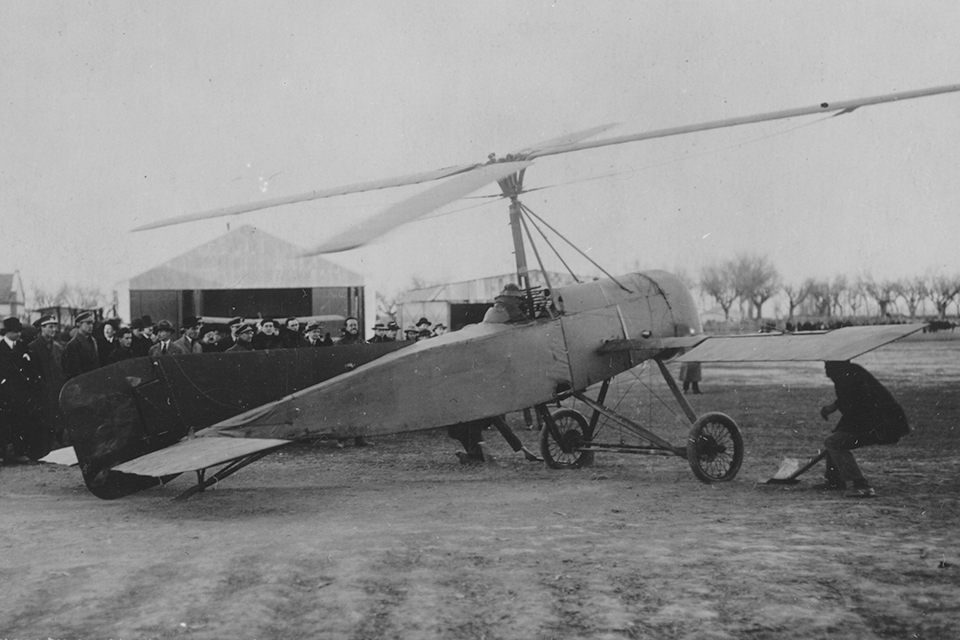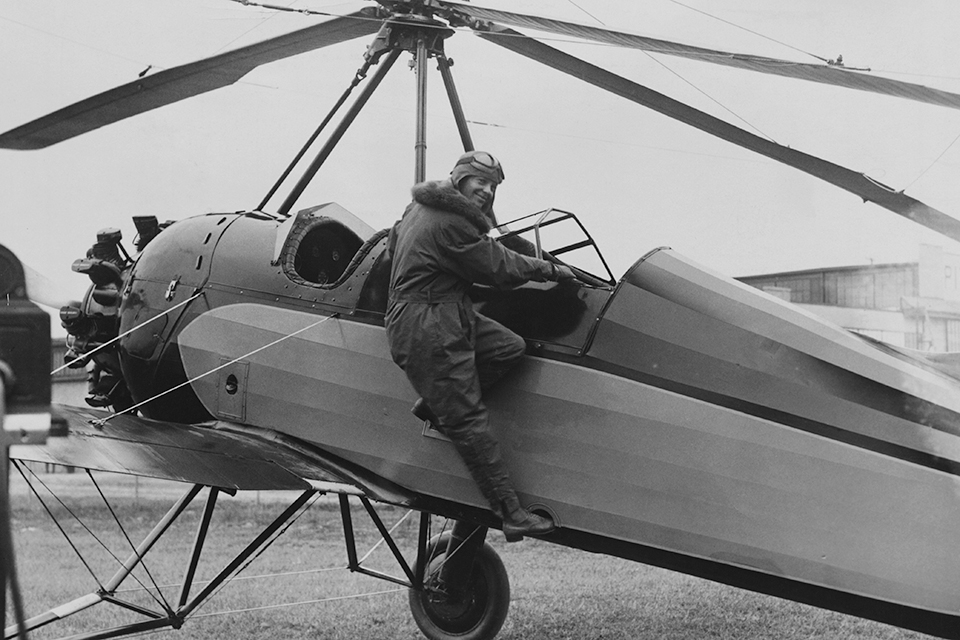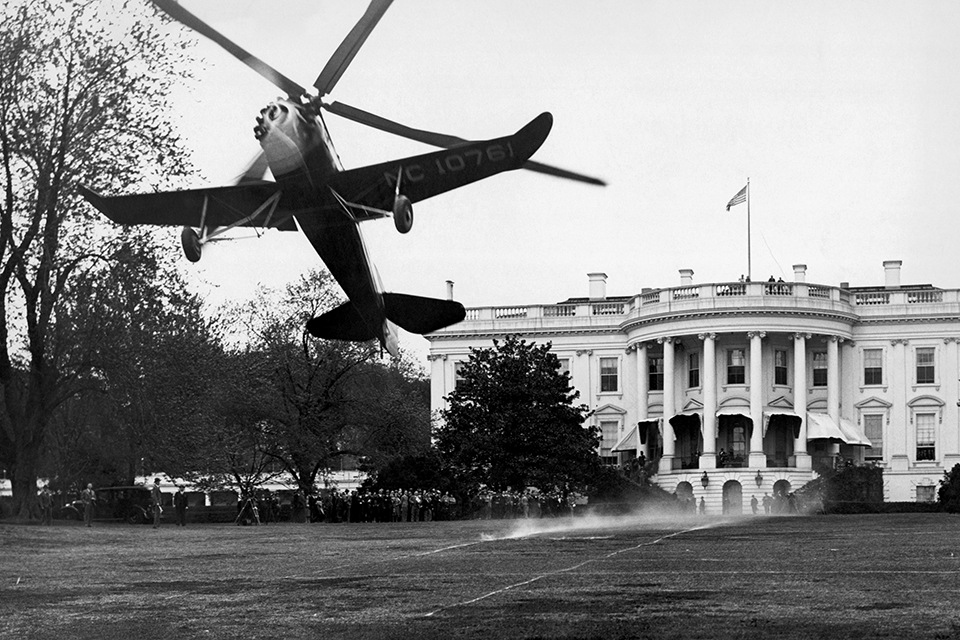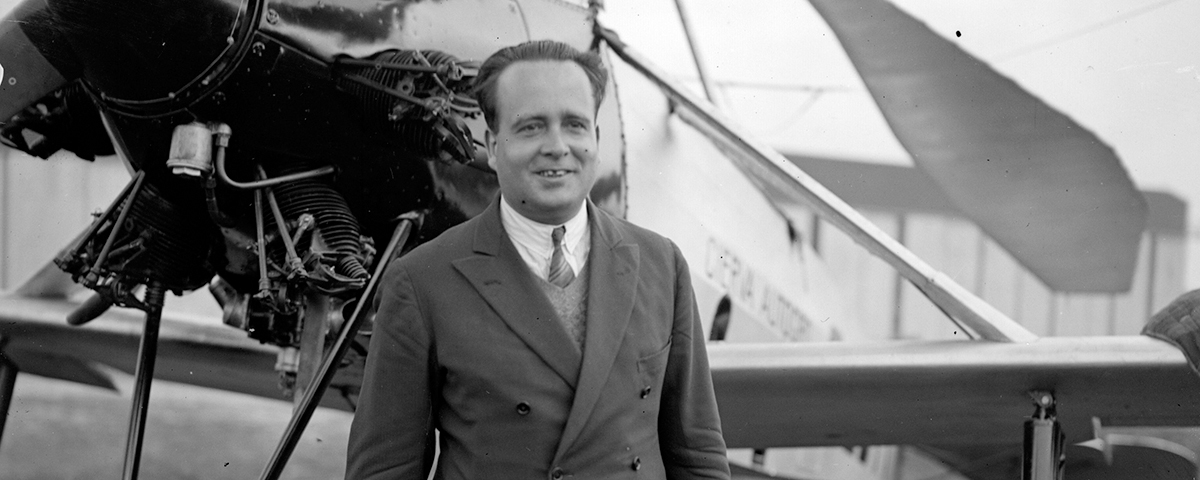Juan de la Cierva made several pivotal breakthroughs that helped solve the stability and control problems of early rotorcraft.
Man dreamed of vertical flight long before Leonardo da Vinci made his famous 1483 sketch of a lifting airscrew and theorized that “if this instrument with a screw be well made….and be turned swiftly, the said screw will make its spiral in the air and it will rise high.” It wasn’t until the first two decades of the 20th century, however, that interest in rotary-wing development intensified and experimenters in a dozen nations persisted in trying to make those dreams a reality.
Due to inherent problems of torque, lifting dissymmetry and control, progress with rotorcraft came very slowly compared to the improvements in fixed-wing aircraft after the Wright brothers’ success in 1903. The names of early rotorcraft pioneers, rarely remembered today, include Gaetano Crocco of Italy, who patented a cyclic pitch mechanism in 1906. The French brothers Louis and Jacques Breguet built a gyroplane that hovered for one minute in 1907. That same year, Paul Cornu, a French bicycle maker, is credited with making a helicopter with counter-rotating rotors rise in full flight with him aboard for about 20 seconds. Two years later, Igor Sikorsky built a pair of helicopters in Russia with dual coaxial rotors, but the engines were underpowered, and both machines vibrated dangerously. In his autobiography, he wrote that a successful helicopter had to await “better engines, lighter material and experienced mechanics.”
Sikorsky’s fellow countryman Boris Yuriev designed a machine in 1912 that demonstrated rotor blades would keep turning of their own accord and allow a safe landing after a gliding descent, but it also suffered from an undersized engine. Danish aviation pioneer Jacob Ellehammer’s 1912 coaxial craft, with counter-rotating rotors and a primitive cyclic pitch control, was said to have made several tentative hops before a crash ended his experiments. In the closing months of World War I, Hungarians Theodore von Kármán and Stephan Petróczy and Bohemian engineer Wilhelm Zurovec built and flew a machine powered by three rotary engines for the Austro-Hungarian army. Conceived as a rotary-winged alternative to kite balloons, the experimental craft made numerous short tethered flights to as much as 150 feet altitude; a quick-opening parachute and inflated rubber bags helped soften landings.
Other experimenters included Americans Emile and Henry Berliner; Raul Pescara, an Argentinean working in Europe; and Louis Brennan of Britain, all of whom claimed limited success when their aircraft rose and briefly flew. But none of them could solve the inherent instability problems.

In the United States, George De Bothezat, a Russian émigré, built a complex four-rotor machine powered by a 180-hp Le Rhône engine and test-flew it at the Army Air Service’s McCook Field in December 1922. Its best performance was a height of 30 feet and a total lifting weight of 4,400 pounds. Unfortunately, it cost more than $200,000, too much for the meager Air Service budget of that time to allow for continued testing of such an unorthodox aircraft. Even so, Thomas Edison wrote De Bothezat in February 1923, “You certainly have made a great advancement; in fact, as far as I know, the first successful helicopter.”
French designer Etienne Oemichen made six different flying machines. They all featured a multitude of whirling airscrews, with at least one for each different control movement over all three axes. One was a four-rotor arrangement with two propellers for propulsion, another for directional control and five more variable-pitch propellers for stability control. He won an award in 1924 for flying his last machine a distance of 5,550 feet at an altitude of 50 feet for 14 minutes.
Meanwhile in Murcia, Spain, young engineer Juan de la Cierva Cordorniu, eldest son of a distinguished Spanish politician, was poised to upstage them all. Born on September 21, 1895, he became interested in aeronautics as a teenager and studied the work of Samuel Langley, Clément Ader, Octave Chanute and other pioneers of glider flight. With several friends, Cierva built two gliders in 1911, but both crashed. Undeterred, in 1912 they rebuilt the wreckage of a Sommer biplane into a monoplane known as the BCD-1, which flew surprisingly well and was reportedly the first successful Spanish-built airplane. The small BCD-2 monoplane followed, but a test pilot eventually wrecked it.
Cierva attended Madrid Engineering College and graduated in 1917. Encouraged by his earlier aircraft fabrication experience, he entered a Spanish government military competition and designed a large trimotor bomber, but it crashed during a test flight in July 1919. Disheartened, he returned to the family business and was briefly involved in politics, becoming a member of the Spanish parliament at age 24.
Cierva remained interested in aviation, however, and he soon turned his attention to the problems of low-speed flight. He was determined to find a way to prevent loss of control, a common cause of accidents, and design an aircraft that could make steep takeoffs and landings at slower speeds than conventional winged aircraft. Cierva observed an interesting phenomenon in 1919, while he was operating a toy helicopter from a balcony at his home, that completely altered his approach to aircraft design. He arrived at a concept of auto-rotating wings attached to a conventional winged aircraft.
Cierva knew that an airplane wing provides lift, but only as it moves forward through the air. He wondered if a rotating wing circling freely over a conventional aircraft would also confer lift as it moved forward. If the engine stopped, he reasoned that the windmill effect of the rotor would act like a parachute, making a safe, nearly vertical landing possible. Cierva called this basic design concept an Autogiro, and it would be the basis for all his subsequent work.
For his first model, the Spanish designer attached a rotor to a Hanriot biplane powered by a Le Rhône engine. After several unsuccessful takeoff attempts with three-and four-bladed rotors rigidly attached to a hub, he tried a five-bladed rotor. Unfortunately, the aircraft crashed as it reached takeoff speed because the rotor blades did not produce equal lift as they turned. Cierva concluded that the problem was due to the gyroscopic action of the rotors and the lack of lift equalization. He tried another approach, designing a four-bladed rotor with the blades hinged horizontally and vertically, allowing them freedom of movement as they spun around the hub. With this blade configuration, airflow compensated for the uneven lift. He designed and built a conventional propeller-equipped aircraft and attached a hinged rotor, resulting in the Cierva C.4.
To test his theory in flight, he persuaded a friend to make a short hop in the C.4 from Madrid’s Getafe Aerodrome in January 1923. It flew for 200 yards close to the ground and proved that it could execute normal aircraft maneuvers as well as rise steeply and land with practically no run after touching down. A newspaper correspondent observed: “The vanes do not move in a level circle but rise and fall with a feathering motion. This is to induce stability, otherwise the vane that is traveling backward would set up a resistance that would tend to offset the efficiency of the one going forward. [The rotor blades] were free to move in a sort of flapping motion wherever they liked according to the effects of the air upon them.”
Cierva’s success with the flapping rotor blades proved to be the single most important discovery in helicopter development. His work with models and then full-sized machines resulted in a series of patents that brought him to the attention of the aeronautical community in other nations. After further testing to prove the machine’s reliability, he moved to Britain in 1925 and secured financing to form the Cierva Autogiro Company Ltd. He worked mainly in England for the rest of his life, refining his designs and supervising construction based on his basic plans under license to manufacturers in Spain, France, Germany and the U.S. The Russians also joined in gyroplane development, but without seeking any licensing.
In February 1927, Royal Air Force test pilot Frank T. Courtney suffered a near-fatal crash when two rotor blades failed on the C.6C he was flying, leading Cierva to drastically improve the rotor hub design. He incorporated a vertical hinge on the blades at the hub, allowing them to hold back briefly and then pivot forward as they rotated to relieve the stresses on each blade. This literally proved pivotal to future helicopter development.
Cierva learned to fly so he could personally test his theories on the further evolution of a practical gyroplane. On September 18, 1928, he flew with a passenger in a C.8L across the English Channel from London to Paris, the first international flight by an Autogiro. He and RAF test pilot Flight Lt. H.C.A. Rawson later made a leisurely 3,000-mile tour of European cities in an improved model to seek licensees, drawing large crowds.
Among those requesting manufacturing rights was Harold F. Pitcairn, a Pennsylvania aircraft designer who had created the Mailwing airplane series in the late 1920s. Pitcairn became interested in developing safer aircraft, and after flying a C.8 during a visit to Britain in 1928, he saw rotorcraft as the ultimate approach to achieving this goal. He formed the Pitcairn-Cierva Autogiro Company to gain the U.S. rights to Cierva’s patents and inventions.

Pitcairn ordered a C.8 with a 220-hp Wright Whirlwind J-5 engine, and had it shipped to America. He invited Lieutenant Rawson to help the company get started in this new direction. On December 19, 1928, Rawson made the first Autogiro and first practical rotary-wing flight in the Western Hemisphere at Bryn Athyn, Pa.
The PCA-1, the Pitcairn-Cierva company’s first successful Autogiro, had the fuselage of a Mailwing, dual rudders and stubby wings with turned-up tips. Three prototypes were turned out in 1929, the first ever manufactured in the U.S. One was demonstrated at the Cleveland Air Races that August, and another participated in an “air parade” at the Newark, N.J., airport.
Pitcairn was the first American to fly an Autogiro, and on May 13, 1929, made the first extended cross-country flight in a PCA-2 from Bryn Athyn to Langley Field, in Virginia. He later flew a modified model with enlarged tail surfaces to Washington, D.C., and demonstrated it to members of Congress.
Cierva enthusiastically claimed that if the Autogiro was mass-produced it would bring flying safety to a new level and cost no more than an average automobile. Pitcairn agreed but knew he had to generate publicity to create a market. Enter Amelia Earhart, who was checked out in a PCA-2 in December 1930. She became the first woman to solo an Autogiro, and soon established a women’s altitude record for the type of 18,415 feet.
Earhart decided to attempt a record-setting transcontinental flight in a PCA-2, with the Beech Nut Company as her sponsor. She departed from Newark on May 29, 1931, and hedge-hopped from city to city westward, giving rides and making demonstration flights to show off the Autogiro’s short-takeoff and slow-landing capabilities. She arrived in Oakland, Calif., on June 12, only to learn she was not the first to make a cross-country flight in an Autogiro; airshow pilot John Miller had flown coast to coast in a PCA-2 two weeks earlier. However, hoping to establish a round-trip record, Earhart set out to return via a southerly route. In Abilene, Texas, she was caught in a sudden tornado-like windstorm and totaled the aircraft in a crash landing. Although unhurt, she had to complete the trip by rail.
Other well-known pilots of the era also checked out in the PCA-2, and several of the Autogiros were sold to private owners and the U.S. Navy. On April 22, 1931, Pitcairn received the Collier Trophy for his efforts, but not at the National Aeronautic Association banquet, as is customary. President Herbert Hoover invited him to have a PCA-2 land on the south lawn of the White House for the presentation ceremony. Test pilot James Ray landed gently and rolled less than 10 feet after touchdown, impressing the gathered dignitaries and especially Orville Wright. The president cited Pitcairn “for the greatest achievement in aviation, the value of which has been demonstrated by actual use in the preceding year.” In his response, Pitcairn praised the Autogiro and Cierva, “whose genius and perseverance made possible our part in its development.”Although Cierva had been invited, he was unable to attend because of a government crisis in Spain that prompted his return to ensure the safety of his wife and six children.
Jim Ray made subsequent landings in Washington to demonstrate the Autogiro’s capabilities. On July 22, 1931, he landed the Cierva C.8—the first Autogiro flown in America—on the National Mall in front of the Smithsonian Institution, to be enshrined with other noteworthy aircraft. In a presentation speech, Pitcairn acknowledged Cierva’s contribution to rotorcraft development by saying that the C.8 would remain in the Smithsonian’s care “as a silent reminder of the genius of its inventor.”

Cierva visited the U.S. four times. Everywhere he went he won friends and admirers with his modesty, intelligence and unassuming manner. Over the next decade, his extraordinary insight helped advance Autogiro technology. He was concerned about several landing accidents caused by wind drift, and thought the fixed spindle to which the Autogiro’s whirling blades were attached might be replaced by a tiltable or swiveling spindle. If the spinning blades could be simultaneously (“collectively”) moved to lift-generating angles of attack, while at the same time the rotor drive system was disengaged so the engine’s power could be transmitted to the conventional propeller for forward thrust, the stored kinetic energy would generate lift and cause the aircraft to rise vertically. Thus the theory of combining cyclic and collective control was born. It was this development of the “direct-control” rotor on a modified C.19 that led to the elimination of the short wings and ailerons. With this system, the rotor could be tilted and thus pull the Autogiro in the direction of tilt.
Pitcairn incorporated Cierva’s changes into progressively heavier models that he promoted extensively; the largest was the plush cabin PA-19, which could carry five people more than 120 miles. The last of the 83 models Pitcairn produced, the PA-39, was built in 1941 (two prototype PA-44s were constructed in 1942 for the Army Air Forces as YO-61s, but were not accepted).
Pitcairn granted licenses to the Buhl and Kellett aircraft companies for production in the U.S. of his models (by then generically known as autogiros, and often spelled “autogyros”). Buhl built only one model in 1931, the A-1, which was the first pusher-type autogiro. Kellett produced 39 autogiros between 1937 and 1942. Eastern Air Lines used a KD-1 to fly airmail from the rooftop of the Philadelphia Post Office across the Delaware River to Camden Central Airport beginning on July 6, 1939, but the service was terminated a year later. The KD-1/G-1 was the first rotor-wing aircraft employed by the Army Air Corps, which bought 14 of them. The U.S. Border Patrol used six Kelletts along the Mexico border. The company ceased production in the early 1940s.
Meanwhile, Cierva’s success had inspired a number of gyroplane experimenters in other nations, each with their own innovations and variations but most following the same basic principles of wingless airplane bodies with rotors overhead. These included the Rota seaplane fitted with flotation gear for the British Royal Navy, a five-seat cabin model from Westland Aircraft Works and other variations tested by de Havilland and Avro in Britain, plus the German Focke-Wulf and French Lioré-et-Olivier companies. The Soviets built KaSkr and TsAGI models without license, and the Japanese produced the Kayaba Ka-1 under Kellett license. In all, about 480 autogiros were built, plus about 25 Russian derivatives, though none was completely successful.
Tragedy struck on December 9, 1936, when Cierva, then 41, died in the crash of a Douglas DC-2 on takeoff from London’s Croydon Airport. His untimely passing merited many obituaries from those who had followed his pioneering efforts in rotary-wing aircraft development. Harold Pitcairn summarized the Spanish designer’s legacy when he said, “All helicopters and similar types of aircraft that have shown promise of practical performance incorporate some of the principles and inventions developed by Cierva.” Although autogiro development continued after Cierva’s death, interest waned with the arrival of true helicopters in Europe and the success in the U.S. of Igor Sikorsky and his VS-300 helicopter in 1939.
Autogiros experienced a resurgence in the late 1950s and ’60s, mostly due to the popularity of Russian immigrant Igor Bensen’s B-8M Gyrocopter, a simple steelor aluminum-tube design with a pusher engine. Today homebuilt Bensen Gyrocopters still fly out of small airports across America.
In retrospect, Cierva’s major contributions were the practical demonstration of autorotation and the use of flapping hinges on rotor blades. A later contribution was the drag hinge on the rotors, enabling the blades to move slightly in relation to each other in their plane of rotation and thus relieve the stresses produced in the blade roots. Other developments by Cierva included direct control by tilting the rotor head and over-speeding the rotor on the ground through an engine drive, then declutching the drive and simultaneously giving the blades extra pitch to lift the aircraft vertically.
To his lasting credit, the modest designer from Spain not only invented and refined the technology behind the Autogiro and other early rotorcraft, he also supervised and personally tested many of his developments. He deserves to be remembered for his genius and persistence in pursuing the dreams of vertical flight expressed so many centuries ago.
Contributing Editor C.V. Glines is a retired U.S. Air Force colonel and the author of many aviation-related books and articles. For further reading, he recommends: Cierva Autogiros: The Development of Rotary-Wing Flight, by Peter W. Brooks; and Legacy of Wings: The Harold F. Pitcairn Story, by Frank Kingston Smith.
Originally published in the September 2012 issue of Aviation History. To subscribe, click here.





